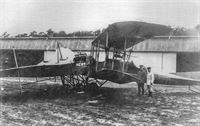
Описание
Страна: Германия
Год: 1913
Варианты
- Jeannin - Stahltaube - 1912 - Германия
- DFW - Taube - 1913 - Германия
- J.Herris DFW Aircraft of WWI (A Centennial Perspective on Great War Airplanes 29)
- Журнал Flight
-
J.Herris - DFW Aircraft of WWI /Centennial Perspective/ (29)
DFW Stahltaube (Steel Dove) ready for another sortie; it had a 100 hp Mercedes and a simpler undercarriage than most Taube designs. The exhaust pipe was directed downward to exhaust under the fuselage. (Peter M. Bowers Collection/Museum of Flight)
-
J.Herris - DFW Aircraft of WWI /Centennial Perspective/ (29)
The DFW Stahltaube (Steel Dove) had a 100 hp Mercedes or 95 hp Daimler and a simpler undercarriage than most Taube designs.The exhaust pipe was directed downward to exhaust under the fuselage. (Peter M. Grosz Collection/SDTB)
-
J.Herris - DFW Aircraft of WWI /Centennial Perspective/ (29)
DFW military Taube with radiator mounted under the engine. This low-drag radiator was unique to DFW Taubes. (Peter M. Bowers Collection/Museum of Flight)
-
J.Herris - DFW Aircraft of WWI /Centennial Perspective/ (29)
DFW military Taube A.5/14 (DFW works number 84) with streamlined radiator mounted under the engine. The photos were taken in the summer of 1914 right after the pristine aircraft left the factory. (Peter M. Grosz Collection/SDTB)
-
J.Herris - DFW Aircraft of WWI /Centennial Perspective/ (29)
DFW military Taube A.5/14 (DFW works number 84) with streamlined radiator mounted under the engine. The photos were taken in the summer of 1914 right after the pristine aircraft left the factory. (Peter M. Grosz Collection/SDTB)
-
J.Herris - DFW Aircraft of WWI /Centennial Perspective/ (29)
DFW military Taube with radiator mounted under the engine. (Peter M. Grosz Collection/SDTB)
-
J.Herris - DFW Aircraft of WWI /Centennial Perspective/ (29)
This DFW Stahltaube (Steel Dove) was photographed at the DFW factory with DFW Chief Pilot Heinrich Oelerich. (Peter M. Grosz Collection/SDTB)
-
J.Herris - DFW Aircraft of WWI /Centennial Perspective/ (29)
DFW military Taube with iron cross national insignia. (Peter M. Grosz Collection/SDTB)
-
J.Herris - DFW Aircraft of WWI /Centennial Perspective/ (29)
This DFW military Taube was photographed at the DFW factory. (Peter M. Grosz Collection/SDTB)
-
J.Herris - DFW Aircraft of WWI /Centennial Perspective/ (29)
Early DFW biplane at right with a Taube at left ready for another sortie early in the fighting. (Peter M. Grosz Collection/SDTB)
Другие самолёты на фотографии: DFW Pfeil Doppeldecker - Германия - 1913
-
J.Herris - DFW Aircraft of WWI /Centennial Perspective/ (29)
DFW trainers at the DFW flying school at Lubeck-Travemunde; a B.I at left with a lineup of Taubes. DFW also owned the Lubeck-Travemunde floatplane production factory; those floatplanes are covered in German Seaplanes of WWI.
Другие самолёты на фотографии: DFW B.I - Германия - 1914
-
M.Bowden - The Great War's Finest. Volume1: Western Front 1914 /Aeronaut/ (1)
DFW В-I на выставке трофейных вооружений в Париже, 1915 год
DFW B.I B.451/14 on display in Paris in September 1914 after being captured; a captured Taube is in the background. The early national insignia on the rudder and both sides of all wings are well shown from this angle. Despite being liberally marked with national insignia many aviators were subject to 'friendly fire' due to poor type recognition. (Aeronaut)Другие самолёты на фотографии: DFW B.I - Германия - 1914
-
J.Herris - DFW Aircraft of WWI /Centennial Perspective/ (29)
This refined DFW Taube with modernized tail design with elevators, rudder, and fixed fin was the next and final step in DFW Taube evolution, but the wings still used warping and not ailerons. The Taube configuration was obsolete. The fin and rudder design was similar to the Mars monoplanes and biplanes. (Peter M. Grosz Collection/SDTB)
-
J.Herris - DFW Aircraft of WWI /Centennial Perspective/ (29)
In addition to the crashes, there were always taxi accidents, a particular hazard for these early aircraft without brakes. Here a DFW Mars biplane has experienced a close encounter of the worst kind with a Taube.
Другие самолёты на фотографии: DFW Mars biplane - Германия - 1912
-
M.Bowden - The Great War's Finest. Volume1: Western Front 1914 /Aeronaut/ (1)
Crash of DFW military Taube A.183/13. Early national insignia are carried. This aircraft was assigned to Flieger Bataillon 1 in March 1913. (Peter M. Grosz Collection/SDTB via Aeronaut)
-
J.Herris - DFW Aircraft of WWI /Centennial Perspective/ (29)
Crash of DFW military Taube A.183/13. Early national insignia are carried. This aircraft was assigned to Flieger Bataillon 1 in March 1913. (Peter M. Grosz Collection/SDTB)
J.Herris DFW Aircraft of WWI (A Centennial Perspective on Great War Airplanes 29)
DFW Tauben
The DFW Stahltaube (Iron Dove) was one of many derivatives of the Jeannin Taube (Dove) configuration. The DFW Military Taube was another that had its streamlined radiator mounted under the nose. Built in various versions in 1913-1914, these aircraft had a variety of six-cylinder engines like the 100 hp Mercedes. Empty weight was 820 kg.
Описание:


















